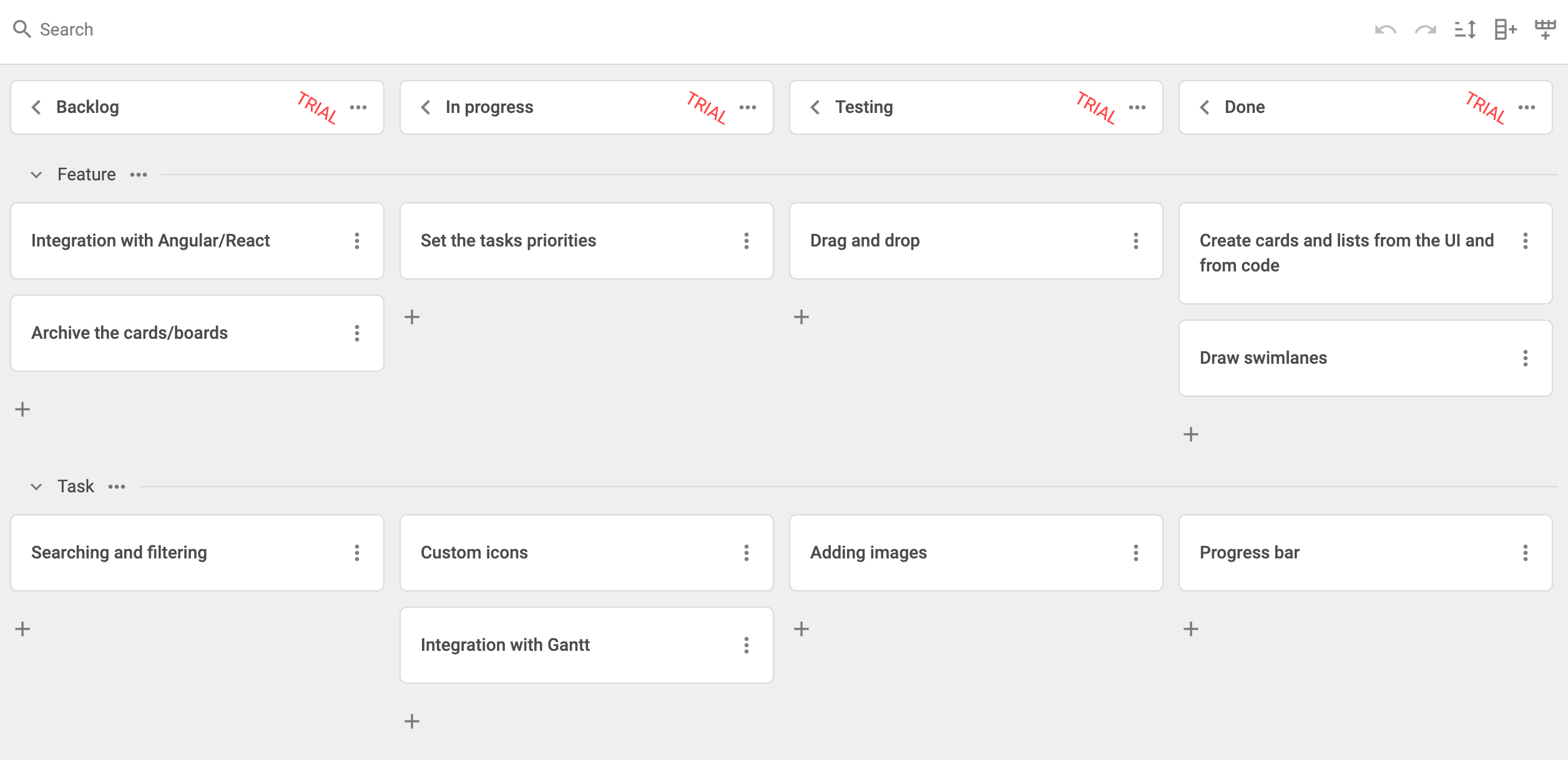与 Angular 的集成
在阅读本篇文档前,您应熟悉 Angular 的基本概念和模式。如需回顾相关知识,请参考 Angular documentation。
DHTMLX Kanban 与 Angular 兼容。我们已经准备了如何在 Angular 中使用 DHTMLX Kanban 的代码示例。更多信息请参阅对应的 GitHub 示例。
创建项目
在开始创建新项目之前,请先安装 Angular CLI 和 Node.js。
使用 Angular CLI 创建一个新的 my-angular-kanban-app 项目。请运行以下命令:
ng new my-angular-kanban-app
如果您希望按照本指南操作,请在创建新的 Angular 应用时禁用服务端渲染(SSR)和静态站点生成(SSG/Prerendering)!
上述命令会安装所有必要工具,无需额外运行其他命令。
安装依赖
进入新创建的应用目录:
cd my-angular-kanban-app
安装依赖并启动开发服务器。为此,请使用 yarn 包管理器:
yarn
yarn start
应用将会在本地(例如 http://localhost:3000)运行。
创建 Kanban
接下来需要获取 DHTMLX Kanban 的源代码。首先,停止当前应用并开始安装 Kanban 包。
步骤 1. 安装包
下载 试用版 Kanban 包,并按照 README 文件中的步骤进行操作。请注意,试用版 Kanban 仅可使用 30 天。
步骤 2. 创建组件
现在需要创建一个 Angular 组件,将 Kanban 和 Toolbar 添加到应用中。在 src/app/ 目录下创建 kanban 文件夹,并在其中新建一个名为 kanban.component.ts 的文件。
导入源文件
打开 kanban.component.ts 文件并导入 Kanban 源文件。请注意:
- 如果您使用 PRO 版本并从本地文件夹安装 Kanban 包,导入路径如下:
import { Kanban, Toolbar } from 'dhx-kanban-package';
- 如果您使用 Kanban 的试用版,请指定如下路径:
import { Kanban, Toolbar } from '@dhx/trial-kanban';
本教程展示了如何配置 trial 版本的 Kanban。
设��置容器并初始化带有 Toolbar 的 Kanban
要在页面上显示带有 Toolbar 的 Kanban,需要为 Kanban 和 Toolbar 设置容器,并使用相应的构造函数初始化这些组件:
import { Kanban, Toolbar } from '@dhx/trial-kanban';
import { Component, ElementRef, OnInit, ViewChild, OnDestroy, ViewEncapsulation} from '@angular/core';
@Component({
encapsulation: ViewEncapsulation.None,
selector: "kanban", // 在 "app.component.ts" 文件中以 <kanban /> 形式使用的模板名
styleUrls: ["./kanban.component.css"], // 引入 css 文件
template: `<div class = "component_container">
<div #toolbar_container></div>
<div #kanban_container class = "widget"></div>
</div>`
})
export class KanbanComponent implements OnInit, OnDestroy {
// 初始化 Toolbar 容器
@ViewChild("toolbar_container", { static: true }) toolbar_container!: ElementRef;
// 初始化 Kanban 容器
@ViewChild("kanban_container", { static: true }) kanban_container!: ElementRef;
private _kanban!: Kanban;
private _toolbar!: Toolbar;
ngOnInit() {
// 初始化 Kanban 组件
this._kanban = new Kanban(this.kanban_container.nativeElement, {});
// 初始化 Toolbar 组件
this._toolbar = new Toolbar(this.toolbar_container.nativeElement, {
api: this._kanban.api,
// 其他配置属性
});
}
ngOnDestroy(): void {
this._kanban.destructor(); // 销毁 Kanban
this._toolbar.destructor(); // 销毁 Toolbar
}
}
添加样式
为了正确显示 Kanban,需要提供相应的样式。为此,您可以在 src/app/kanban/ 目录下创建 kanban.component.css 文件,并为 Kanban 及其容器指定必要样式:
/* 导入 Kanban 样式 */
@import "@dhx/trial-kanban/dist/kanban.css";
/* 为初始页面指定样式 */
html,
body{
height: 100%;
padding: 0;
margin: 0;
}
/* 为 Kanban 和 Toolbar 容器指定样式 */
.component_container {
height: 100%;
margin: 0 auto;
}
/* 为 Kanban 容器指定样式 */
.widget {
height: calc(100% - 56px);
}
加载数据
要向 Kanban 添加数据,需要提供一组数据。您可以在 src/app/kanban/ 目录下创建 data.ts 文件,并在其中添加一些数据:
export function getData() {
const columns = [
{
label: "Backlog",
id: "backlog"
},
{
label: "In progress",
id: "inprogress"
},
// ...
];
const cards = [
{
id: 1,
label: "Integration with Angular/React",
priority: 1,
color: "#65D3B3",
start_date: new Date("01/07/2021"),
users: [3, 2],
column: "backlog",
type: "feature",
},
{
label: "Archive the cards/boards ",
priority: 3,
color: "#58C3FE",
users: [4],
progress: 1,
column: "backlog",
type: "feature",
},
// ...
];
const rows = [
{
label: "Feature",
id: "feature",
},
{
label: "Task",
id: "task",
}
];
return { columns, cards, rows };
}
然后打开 kanban.component.ts 文件。导入数据文件,并在 ngOnInit() 方法中将相应的数据属性指定到 Kanban 的配置对象,如下所示:
import { Kanban, Toolbar } from '@dhx/trial-kanban';
import { getData } from "./data"; // 导入数据
import { Component, ElementRef, OnInit, ViewChild, OnDestroy, ViewEncapsulation} from '@angular/core';
@Component({
encapsulation: ViewEncapsulation.None,
selector: "kanban",
styleUrls: ["./kanban.component.css"],
template: `<div class = "component_container">
<div #toolbar_container></div>
<div #kanban_container class = "widget"></div>
</div>`
})
export class KanbanComponent implements OnInit, OnDestroy {
@ViewChild("toolbar_container", { static: true }) toolbar_container!: ElementRef;
@ViewChild("kanban_container", { static: true }) kanban_container!: ElementRef;
private _kanban!: Kanban;
private _toolbar!: Toolbar;
ngOnInit() {
const { cards, columns, rows } = getData(); // 初始化数据属性
this._kanban = new Kanban(this.kanban_container.nativeElement, {
columns, // 应用列数据
cards, // 应用卡片数据
rows, // 应用行数据
rowKey: "type",
// 其他配置属性
});
this._toolbar = new Toolbar(this.toolbar_container.nativeElement, {
api: this._kanban.api,
// 其他配置属性
});
}
ngOnDestroy(): void {
this._kanban.destructor();
this._toolbar.destructor();
}
}
您也可以在 Angular 的 ngOnInit() 方法中使用 setConfig() 或 parse() 方法将数据加载到 Kanban。setConfig 或 parse() 方法在每次应用更改时都能实现数据重新加载。
import { Kanban, Toolbar } from '@dhx/trial-kanban';
import { getData } from "./data"; // 导入数据
import { Component, ElementRef, OnInit, ViewChild, OnDestroy, ViewEncapsulation} from '@angular/core';
@Component({
encapsulation: ViewEncapsulation.None,
selector: "kanban",
styleUrls: ["./kanban.component.css"],
template: `<div class = "component_container">
<div #toolbar_container></div>
<div #kanban_container class = "widget"></div>
</div>`
})
export class KanbanComponent implements OnInit, OnDestroy {
@ViewChild("toolbar_container", { static: true }) toolbar_container!: ElementRef;
@ViewChild("kanban_container", { static: true }) kanban_container!: ElementRef;
private _kanban!: Kanban;
private _toolbar!: Toolbar;
ngOnInit() {
const { cards, columns, rows } = getData(); // 初始化数据属性
this._kanban = new Kanban(this.kanban_container.nativeElement, {
columns: [],
cards: [],
rows: [],
rowKey: "type",
// 其他配置属性
});
this._toolbar = new Toolbar(this.toolbar_container.nativeElement, {
api: this._kanban.api,
// 其他配置属性
});
// 通过 setConfig() 或 parse() 方法应用数据
this._kanban.setConfig({
columns,
cards,
rows
});
}
ngOnDestroy(): void {
this._kanban.destructor();
this._toolbar.destructor();
}
}
现在 Kanban 组件已经可以使用。当该元素被添加到页面时,会自动初始化带有数据的 Kanban。您还可以根据需要提供其他配置设置。请访问我们的 Kanban API 文档 查看所有可用属性的完整列表。
事件处理
当用户在 Kanban 上执行某些操作时,会触发事件。您可以利用这些事件检测操作并执行所需代码。参阅 完整事件列表。
打开 kanban.component.ts 文件,并按以下方式补充 ngOnInit() 方法:
// ...
ngOnInit() {
this._kanban = new Kanban(this.kanban_container.nativeElement, {});
this._kanban.api.on("add-card", (obj) => {
console.log(obj.columnId);
});
}
ngOnDestroy(): void {
this._kanban.destructor();
}
步骤 3. 将 Kanban 添加到应用中
要将 KanbanComponent 组件添加到您的应用中,请打开 src/app/app.component.ts 文件,并用以下内容替换默认代码:
import { Component } from "@angular/core";
@Component({
selector: "app-root",
template: `<kanban/>`
})
export class AppComponent {
name = "";
}
然后在 src/app/ 目录下创建 app.module.ts 文件,并按如下方式指定 KanbanComponent:
import { NgModule } from "@angular/core";
import { BrowserModule } from "@angular/platform-browser";
import { AppComponent } from "./app.component";
import { KanbanComponent } from "./kanban/kanban.component";
@NgModule({
declarations: [AppComponent, KanbanComponent],
imports: [BrowserModule],
bootstrap: [AppComponent]
})
export class AppModule {}
最后一步,打开 src/main.ts 文件,并用以下内容替换现有代码:
import { platformBrowserDynamic } from "@angular/platform-browser-dynamic";
import { AppModule } from "./app/app.module";
platformBrowserDynamic()
.bootstrapModule(AppModule)
.catch((err) => console.error(err));
此后,您即可启动应用,在页面上看到加载了数据的 Kanban。

现在您已经了解如何将 DHTMLX Kanban 集成到 Angular 中。您可以根据具体需求自定义代码。最终的高级示例可在 GitHub 查看。